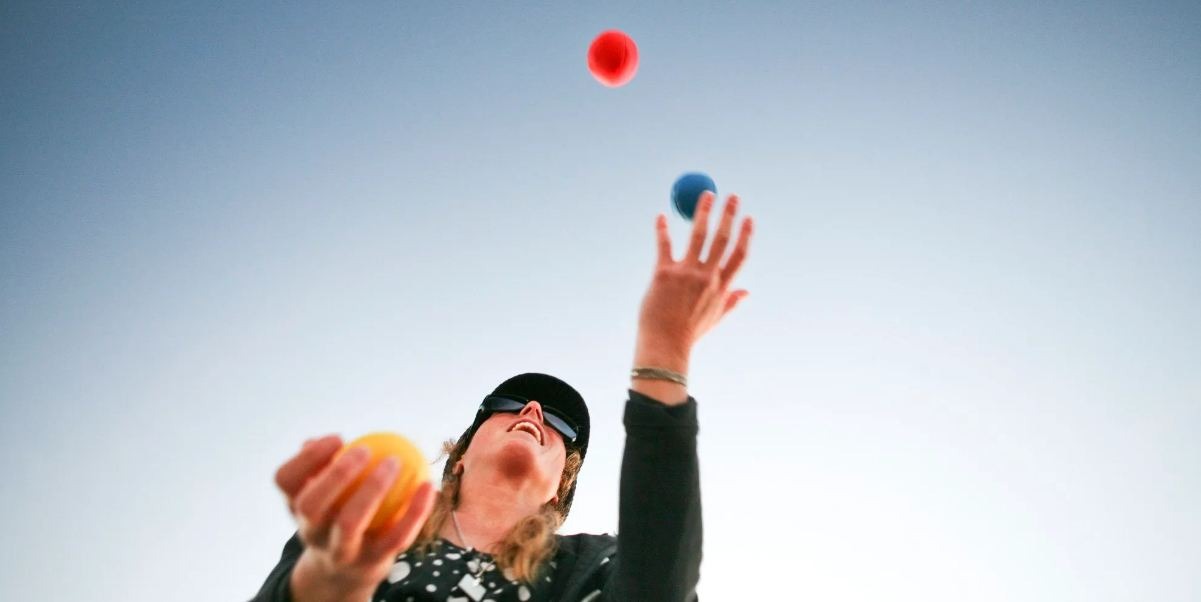Juggling and learning to juggle has many possibilities for team building and motivation. Juggling activities are excellent warm-ups for training and conferences since they are entertaining, unique, and memorable. Juggling and learning to juggle is both intellectually and physically demanding activities. Juggling, and learning how to juggle, is an excellent parallel for the learning process, which is how the mind and body acquire and develop new abilities. Other games and toys, such as plate-spinning, can encourage, excite, and offer a pleasant pastime to create a good environment and foster cooperation.
Juggling Details
| Category: Competition, Performance, Physical | Time: 30-60 min | Skill: Lots |
| Initial Cost: $ (0-50) | Space: little | People: alone |
| Long-Term Cost: Low | Makes Money: No | Location: indoor, outdoor |
History of Juggling
No one has undertaken an in-depth study of juggling before Vaudeville despite the existence of various reference books on jugglers from the Vaudeville period up to now.
Benefits of Juggling
Mind Growth
It encourages the formation of new brain pathways involved in memory, concentration, movement, and vision. According to research, juggling may stimulate the growth of specific brain regions, particularly those involved in visual and motor functions. It aids in the development of strategic thinking as well as attention span.
Boosts Confidence and Focus
Throwing and catching props with precise time and following a predetermined rhythm or pattern teaches you accuracy and rhythm. It gives you more self-assurance as you learn new feats and strive for excellence while doing them.
Betters Academic Performance
According to research, children who learn to juggle exhibit improved academic achievement, reading abilities, and the capacity to focus on their academics.
Scope for Perfection
Juggling is energizing and relaxing at the same time. As you raise or alter the props, improve your juggling pace, or attempt new variants, it lets you take control of your actions and prepare for new challenges. It encourages you to learn from your errors and to keep practicing until you have perfected your trade. Juggle will help you succeed at school, in business, in relationships, and sports.
Facilitates Mental Stability
It provides stress alleviation since your attention is focused on your work rather than your worries. It also improves your brain clarity, prepares you to face difficulties, and teaches you problem-solving techniques.
Reduces Degenerative Diseases
Juggling enhances cognitive processes in the brain and protects against degenerative illnesses like Alzheimer’s and Parkinson’s. It diverts your attention away from eating and decreases food cravings. It has also been shown to aid in the cessation of addictive behaviors and to develop tremendous willpower.
Improves Coordination
Hand-eye coordination, response speed, reflexes, spatial understanding, skill, and timing are all improved by juggling. Additionally, it improves peripheral vision.
Materials for Juggling
Juggling Scarves – The cascade pattern is the most effective way for novices to learn how to juggle. Other than that, it is seldom used.
Juggling Beanbags – The most widely used juggling apparatus. Size, quality, and material all differ significantly.
Juggling Rings – After learning to juggle balls or beanbags, jugglers usually learn to juggle knives.
Juggling Clubs – In most cases, this is the following step towards intermediate juggling. There is a wide variety of various kinds and qualities to choose from.
Juggling Torches and Knives – The additional element of risk should only be tried after learning juggling clubs.
Diabolo resembles a big yoyo operated by two sticks with a thread in between; it is also known as a Chinese Yoyo. It is trendy among those who do not juggle.
Devil Sticks – It is also known as a flower stick. It is a simple game to pick up and play. Two hand sticks control one big post with weighted ends or tassels.
Cigar Boxes – A juggling variant in which rectangles that resemble cigar boxes are handled. It is unusual to come across a competent performer of this unique talent.
Poi – The flow arts community considers it to be trendy. There are many variants of a weighted item that is attached to strings and swings.
Tips for beginning jugglers
- If your props are flying all over the place as you throw them in the air for practice, slow down. You will have more time to fine-tune the direction of your toss as a result.
- Do hand workouts with both hands if the prop slips from your grasp while trying to grab it. You will be able to close your palm around the prop faster and avoid dropping it as a result of improving your motor skills.
- Use your dominant hand and your subordinate hand to practice throwing three props in a similar arc.
- Use both dominant and subordinate hands to practice throwing objects. To begin, lead with your dominant hand and toss the prop. As soon as you have mastered that move, try throwing the prop leading with your other hand.
- It is best to conduct your juggling outside where you will have more freedom to make mistakes and learn from them before becoming an expert. Select a location with a lot of open space. Ideally, it would help if you practiced in an area where you can walk on the grass. When juggling, avoid standing with your back to the sun.
- Make sure you are throwing the objects at different levels of height to get the best results. You will quickly discover what height is most comfortable for you.
Is juggling a profitable hobby?
It is possible to contact local promoters to find out whether they are looking for a new juggling act if you are skilled at juggling and believe that you have an exciting routine and that people would enjoy seeing. A unique performer who can get five objects in the air but has never performed before must create an act.
When juggling in front of an audience, you need to be more than just a thrower of items. Some people enjoy telling stories and making others laugh. Some people even manage to juggle deadly things in their hands. Another option is to make it into a stand-up routine. Identify your area of expertise, create a solid performance, and people will be clamoring for your services.
Conclusion
A timeless ritual and art form, juggling has always been appealing to both adults and children. When we witness someone expertly juggling, a part of us wants to give it a go and see if we can do it, too! Many hours, if not years, of work and dedication, are required for those who can successfully juggle four, five, or even ten objects. However, the fundamental notion remains the same whether you deal with three, four, or more items.
Successful juggling relies heavily on peripheral vision, and mastering its use is essential to getting the age-old art of juggling.


